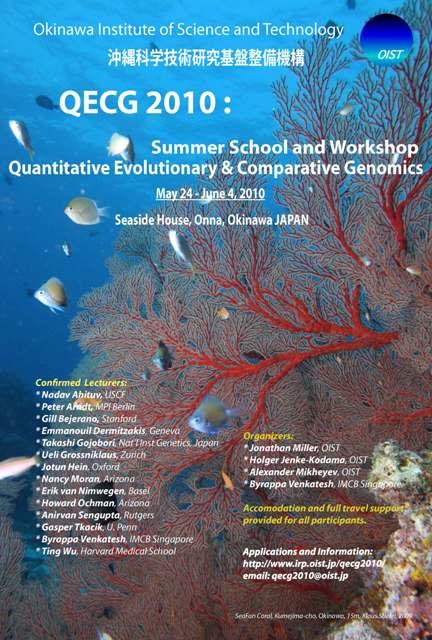QECG2010
Lecturers | Organizers | Lectures | Tutorials | Poster
Overview
Dates: May 24 - June 4, 2010
The theme of the 2010 Summer School was the phenomenon of strong (or extreme) sequence conservation, which was explored from a quantitative and multidisciplinary perspective, and connections forged with parts of biology outside of genomics.
Sequence conservation forms the basis of comparative genomics, has already played a pivotal role in biology and medicine, and is likely to become increasingly important in the eras of abundant sequence data and the personalized genome. Ultra-conservation has led to a broad appreciation of the need for a reevaluation of how the action of selection is inferred from sequence comparison. It has raised basic questions about the character of "neutral drift," calling for new quantitative developments that may be facilitated by the cultures of mathematics, physics, computer science, and engineering; however, this pursuit - and the interpretation of genome sequence in general - ought to be firmly grounded in its biological context.
With a multitude of whole-genome sequences now publicly available, ultra-conservation is trivial to exhibit, but so far difficult to explain. Therefore it represented an ideal topic for a combined Summer School and Workshop, where the phenomenon could be appreciated by participants of diverse backgrounds, who could then bring their own perspectives to bear on the problem.
Broad Topic Categories:
- Ultra-conservation: Theory & Experiment.
- Ultra-conserved Elements (UCEs) within Populations.
- Comparative, Evolutionary and Population Genomics.
- Recombination and Genome Rearrangement.
- Neutral and Adaptive Evolution: Proteins, RNA, Regulatory Sequences, Genomes.
- Experimental Evolution.
The format of the summer school consisted of a three-hour presentation in the morning, with coffee breaks, followed by an hour or two of discussion in the afternoon.
Lecturers
- Nadav Ahituv, UCSF
- Peter Arndt, MPI Berlin
- Gill Bejerano, Stanford
- Emmanouil Dermitzakis, Geneva
- Takashi Gojobori, National Institute of Genetics, Japan
- Ueli Grossniklaus, Zurich
- Jotun Hein, Oxford
- H.C. Paul Lee, NCU Taiwan
- Jonathan Miller, OIST
- Nancy Moran, Arizona
- Erik van Nimwegen, Basel
- Howard Ochman, Arizona
- Anirvan Sengupta, Rutgers
- Gasper Tkacik, U. Penn
- Byrappa Venkatesh, IMCB Singapore
- Ting Wu, Harvard Medical School
Organizers
- Jonathan Miller, OIST
- Holger Jenke-Kodama, OIST
- Alexander Mikheyev, OIST
- Byrappa Venkatesh, IMCB Singapore
- Oleg Gusev, NAIS Tsukuba (poster sessions)
Lectures
| Lecturer | Title (Provisional) | |
|---|---|---|
| Nadav Ahituv, UCSF | Functional characterization of evolutionarily conserved non-coding sequences. | |
| Peter Arndt, MPI Berlin | Dynamical models describing nucleotide evolution. | |
| Gill Bejerano, Stanford | Ultra-conservation: the hip and the hype. | |
| Emmanouil Dermitzakis, Geneva | Population genetics of genome evolution. | |
| Takashi Gojobori, National Institute of Genetics, Japan | Genomic evolution of the neural system. | |
| Ueli Grossniklaus, Zurich | Landscape and comparative genomics in plants - a tale of adaptation, extinction and ultra-conservation. | |
| H.C. Paul Lee, NCU Taiwan | Quantitative genome evolution. | |
| Nancy Moran, Arizona | Genome reduction in genomes of symbiotic bacteria. | |
| Erik van Nimwegen, Basel | Quantitative laws of bacterial evolution. | |
| Howard Ochman, Arizona | The simplicity and complexity of bacterial genomes. | |
| Anirvan Sengupta, Rutgers | Long-range regulation: enhancers and insulators. | |
| Gasper Tkacik, U. Penn | From statistical mechanics to information theory: tools for understanding biophysical systems. | |
| Byrappa Venkatesh, IMCB Singapore | Evolution of Hox gene clusters in vertebrates. | |
| Ting Wu, Harvard Medical School | Ultra-conservation from the standpoint of genome integrity: from copy-counting to meiotic gene silencing. | |
Tutorials
- Jotun Hein, Oxford: Statistical alignment and footprinting.
- H.C. Paul Lee, NCU Taiwan: Quantitative genome evolution.
- Erik van Nimwegen, Basel: General probabilistic methods for identification and prediction of regulatory motifs and regulatory sites using comparative genomic data.
- Gasper Tkacik, U. Penn
Poster
QECG2010 Poster [QECG2010.pdf] [QECG2010.jpg]




